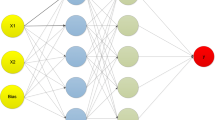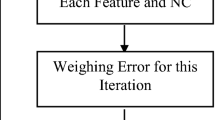Abstract
This paper presents a new clustering procedure based on K-means and self-organizing map (SOM) network algorithms for classification of earthquake ground-motion records. Six scalar indicators are used in data analysis for describing the frequency content features of earthquake ground motions, named as the average spectral period (T avg ), the mean period (T m ), the smoothed spectral predominant period (T 0), the characteristic period (T 4.3), the predominant period based on velocity spectrum (T gSv ), and the shape factor (Ω). Different clustering validity indexes were applied to determine the best estimates of the number of clusters on real and synthetic data. Results showed the high performance of proposed procedure to reveal salient features of complex seismic data. The comparison between the results of clustering analyses recommend the smoothed spectral predominant period as an effective indicator to describe ground-motion classes. The results also showed that K-means algorithm has better performance than SOM algorithm in identification and classification procedure of ground-motion records.






















Similar content being viewed by others
References
Alimoradi A, Pezeshk S, Naeim F, Frigui H (2005) Fuzzy pattern classification of strong ground motion records. J Earthq Eng 9(3):307–302
American Society of Civil Engineers (ASCE) (2000) Prestandard and commentary for the seismic rehabilitation of buildings, prepared for the SAC joint venture, published by the Federal Emergency Management Agency, FEMA-356, Washington, D.C.
Boore D (2003) Prediction of ground motion using the stochastic method. Pure Appl Geophys 160:635–676
Bragato PL, Laurenzano G, Barnab C (2007) Automatic zonation of urban areas based on the similarity of h/v spectral ratios. Bull Seismol Soc Am 97:1404–1412
Bray JD, Rathje E, Augello AJ, Merry SM (1998) Simplified seismic design procedure for geosynthetic-lined, solid-waste landfills. Geosynthet Int 5(1–2):203–235
Brun M, Sima C, Hua J, Lowey J, Carroll B (2007) Model-based evaluation of clustering validation measures. Pattern Recogn 40:807–824
Building Seismic Safety Council (BSSC) (1997) Edition NEHRP recommended provisions for seismic regulations for new buildings and other structures, developed for the Federal Emergency Management Agency, FEMA302/303. Washington. D.C
Calinski T, Harabasz J (1974) A dendrite method for cluster analysis. Commun Stat 3:1–27
Carniel R, Barbui L, Malisan P (2009) Improvement of HVSR technique by self-organizing map (SOM) analysis. Soil Dyn Earthq Eng 29:1097–1101
Chen G, Jaradat SA, Banerjee N, Tanaka TS, Ko MSH, Zhang MQ (2002) Evaluation and comparison of clustering algorithms in anglyzing ES cell gene expression data. Stat Sin 12:241–262
Craifaleanu I (2011) Investigation of the frequency content of ground motions recorded during strong Vrancea earthquakes, based on deterministic and stochastic indices, International conference on Structural Dynamics, EURODYN 2011, Leuven, Belgium, July 4–6, paper no. MS16–832
Craifaleanu I (2012) An assessment of relevance of parameters used for ground motion frequency content characterization with application to Vrancea subcrustal earthquakes, 15 World Conference of Earthquake Engineering, 15WCEE, Lisbon, September 24–28
Davies DL, Bouldin DW (1979) Cluster separation measure. IEEE Trans Pattern Anal Mach Intell 1(2):95–104
Dimitrakopoulos E (2011) Seismic response analysis of skew bridges with pounding deck–abutment joints. Eng Struct 33(3):813–826
Dunn JC (1974) Well separated clusters and optimal fuzzy partitions. J Cybernetica 4:95–104
Elia G, Rouainia M (2013) Seismic performance of earth embankment using simple and advanced numerical approaches. J Geotech Geoenviron 139(7):1115–1129
Fahjan YM (2008) Selection and scaling of real earthquake accelerograms to fit the Turkish design spectra. Teknik Dergi 19(3):4423–4444
Fajfar P, Vidic T, Fischinger M (1990) A measure of earthquake motion capacity to damage medium-period structures. Soil Dyn Earthq Eng 9(5):236–242
Halkidi M, Batistakis Y, Vazirgiannis M (2001) On clustering validation techniques. J Intell Inf Syst 17:107–145
Hancock J, Bommer JJ (2006) A state-of-knowledge review of the influence of strong-motion duration on structural damage. Earthquake Spectra 22(3):827–845
Hartigan JA (1975) Clustering algorithms. Wiley, New York
Hartigan JA, Wong MA (1979) Algorithm AS 136: a k-means clustering algorithm. Appl Stat 28(1):100–108
Hubert L, Schultz J (1976) Quadratic assignment as a general data-analysis strategy. Br J Math Stat Psychol 29:190–241
Iervolino I, Cornell CA (2005) Record selection for nonlinear seismic analysis of structures. Earthquake Spectra 21(3):685–713
Jayaram N, Baker J (2010) Efficient sampling and data reduction techniques for probabilistic seismic lifeline risk assessment. Earthquake Engng Struct Dyn 39:1109–1131
Kane DL, Shearer PM, Goertz-Allmann BP, Vernon FL (2013) Rupture directivity of small earthquakes at Parkfield. J Geophys Res Solid Earth 118:1–10
Karavasilis T, Seo C, Makris N (2011) Dimensional response analysis of bilinear systems subjected to non-pulselike earthquake ground motions. J Struct Eng ASCE 137(5):600–606
Katsanos EI, Sextos AG, Manolis GD (2010) Selection of earthquake ground motion records: a state-of-the-art review from a structural engineering perspective. Soil Dyn Earthq Eng 30:157–169
Kaufman L, Rousseeuw PJ (1990) Finding groups in data: an introduction to cluster analysis. Wiley, New York
Klose CH (2006) Self-organizing maps for geoscientific data analysis: geological interpretation of multidimensional geophysical data. Comput Geosci 10:265–277
Kohler A, Ohrnberger M, Scherbaum F (2010) Unsupervised pattern recognition in continuous seismic wavefield records using self-organizing maps. Geophys J Int 182:1619–1630
Kohonen T (1981) Automatic formation of topological maps of pattern in a self–organizing system, Proceedings of the 2nd Scandinavian conference on image analysis, pattern recognition society of Finland
Kohonen T (2001) Self-organizing maps. Springer, New York p.501
Krzanowski WJ, Lai YT (1985) A criterion for determining the number of groups in a data set using sum-of-squares clustering. Biometrics 44:23–34
Kumar M, Castro J, Stafford P, Elghazouli A (2011) Influence of the mean period of ground motion on the inelastic dynamic response of single and multi degree of freedom systems. Earthq Eng Struct Dyn 40(3):237–256
Kuyuk HS, Yildirim E, Dogan E, Horasan G (2011) An unsupervised learning algorithm: application to the discrimination of seismic events and quarry blasts in the vicinity of Istanbul. Nat Hazards Earth Syst Sci 11:93–100
Kuyuk HS, Yildirim E, Dogan E, Horasan G (2012) Application of k-means and Gaussian mixture model for classification of seismic activities in Istanbu. Nonlin Processes Geophys 19:411–419
Kwon O-S, Elnashai A (2006) The effect of material and ground motion uncertainty on the seismic vulnerability curves of RC structure. Eng Struct 28(2):289–303
Kwon O-S, Sextos AG, Elnashai A, (2008) Liquefaction-dependent fragility relation-ships of complex bridge-foundation-soil systems. In: Proceedings of international conference on earthquake engineering and disaster mitiga- tion. Jakarta, Indonesia
Lopez-Caballero F, Modaressi Farahmand-Razavi A (2008) Numerical simulation of liquefaction effects on seismic SSI. Soil Dyn Earthq Eng 28(2):85–98
Madahizadeh R, Allamehzadeh M (2009) Prediction of aftershocks distribution using artificial neural networks and its application on the may 12, 2008 Sichuan earthquake. JSEE 11(3):111–120
Miranda E (1993) Evaluation of site-dependent inelastic seismic design spectra. J Struct Eng 119(5):1319–1338
Morales-Esteban A, MartÕnez-àlvarez F, Troncoso A, Justo JJ, Rubio-Escudero C (2010) Pattern recognition to forecast seismic time series. Expert Syst Appl 37:8333–8342
Morikawa H, Udagawa SH (2009) A method to estimate the phase velocities of microtremors using a time-frequency analysis and its applications. Bull Seismol Soc Am 99(2A):774–793
Naeim F, Alimoradi A, Pezeshk S (2004) Selection and scaling of ground motion time histories for structural design using genetic algorithm. Earthquake Spectra 20(2):413–426
Pollard KS, Vander Laan MJ (2002) A method to identify significant clusters in gene expression data”, U.C. Berkeley Division of Biostatistics Working Paper Series, p. 107
Ramdani F, Kettani O, Tadili B (2015) Evidence for subduction beneath Gibraltar arc and Andean regions from k-means earthquake centroids. J Seismol 19(1):41–53
Rathje EM, Antonakos G (2011) A unified model for predicting earthquake-induced sliding displacements of rigid and flexible slopes. Eng Geol 122(1–2):51–60
Rathje EM, Abrahamson NA, Bray JD (1998) Simplified frequency content estimates of earthquake ground motions. J Geotech Geoenviron 124(2):150–159
Rathje EM, Faraj F, Russell S, Bray JD (2004) Empirical relationships for frequency content parameters of earthquake ground motions. Earthquake Spectra 20(1):119–144
Rehman K, Burton PW, Weatherill GA (2014) K-means cluster analysis and seismicity partitioning for Pakistan. J Seismol 18(3):401–419
Rendon E, Abundez I, Arizmendi A, Quiroz EM (2011) Internal versus external cluster validation indexes. Int J Comput Commun 5:27–34
Roy R, Thakur P, Chakroborty S (2014) Scaling of ground motions and its applications to plan-asymmetric structures. Soil Dyn Earthq Eng 57:46–67
Ruiz-Garcia J, Miranda E (2005) Performance-based assessment of existing structures accounting for residual displacements, Report No. 153, The John A. Blume Earthquake Engineering Center, Department of Civil and Environmental Engineering, Stanford University, Stanford, California
Selim SZ, Ismail MA (1984) K-means type algorithms: a generalized convergence theorem and characterization of local optimality. IEEE Trans Pattern Anal Mach Intell 6:81–87
Stewart JP, Chiou S-J, Bray JD, Somerville PG, Graves RW, Abrahamson NA (2001) Ground motion evaluation procedures for performance based design, Report No.PEER-2001/09, Pacific Earthquake Engineering Research Center, September, 229 pp
Tarvainen M (1999) Recognizing explosion sites with a self-organizing network for unsupervised learning. Phys Earth Planet Int 113(1–4):143–154
Tso WK, Zhu TJ, Heidebrecht AC (1992) Engineering implication of ground motion a/V ratio. Soil Dyn Earthq Eng 11(3):133–144
Watson-Lamprey J, Abrahamson N (2006) Selection of ground motion time series and limits on scaling. Soil Dyn Earthq Eng 26:477–482
Weatherill G, Burton PW (2009) Delineation of shallow seismic source zones using K-means cluster analysis, with application to the Aegean region. Geophys J Int 176:565–688
Wu J, Chen J, Xiong H, Xie M (2009) External validation measures for K-means clustering: a data distribution perspective. Expert Syst Appl 36:6050–6061
Yaghmaei-Sabegh S (2015) New models for frequency content prediction of earthquake records based on Iranian ground-motion data. J Seismol 19:831–848
Yaghmaei-Sabegh S, Lam NTK (2010) Ground motion modelling in Tehran based on the stochastic method. Soil Dyn Earthq Eng 14(4):525–535
Yaghmaei-Sabegh S, Tsang H-H (2014) Site class mapping based on earthquake ground motion data recorded by regional seismographic network. Nat Hazards 73:2067–2087
Zamani A, Hashemi N (2004) Computer-based self-organized tectonic zoning: a tentative pattern recognition for Iran. Comput Geosci 30:705–718
Author information
Authors and Affiliations
Corresponding author
Rights and permissions
About this article
Cite this article
Yaghmaei-Sabegh, S. A novel approach for classification of earthquake ground-motion records. J Seismol 21, 885–907 (2017). https://doi.org/10.1007/s10950-017-9642-8
Received:
Accepted:
Published:
Issue Date:
DOI: https://doi.org/10.1007/s10950-017-9642-8




